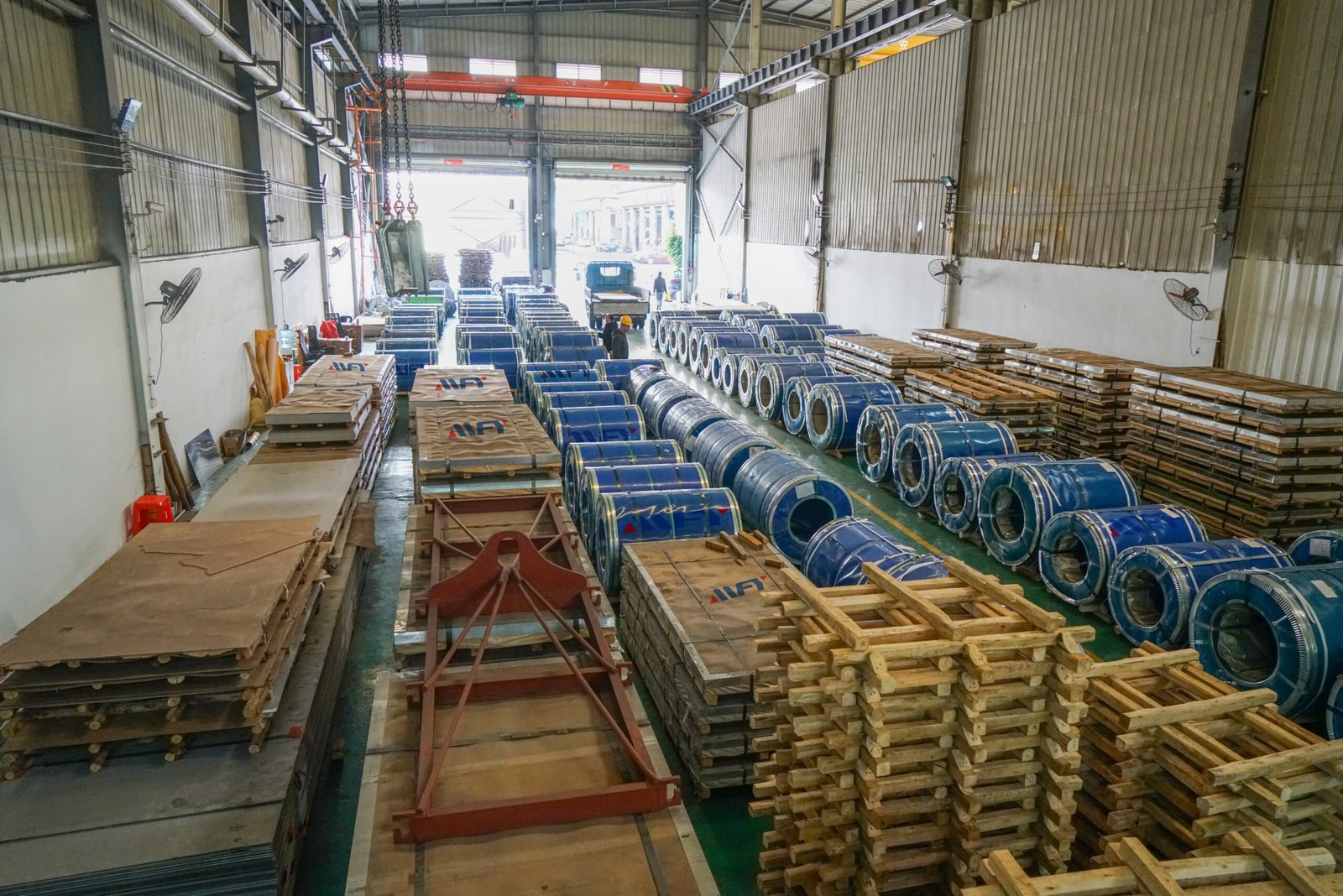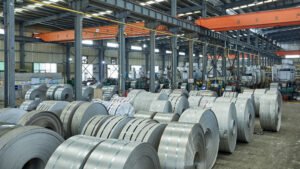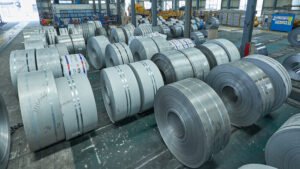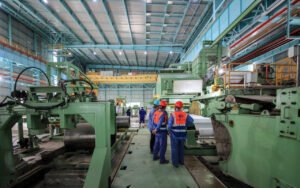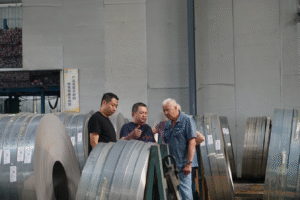A Comprehensive Guide to 0.1mm Stainless Steel 304 Coil

Struggling to find a material that is both incredibly thin and reliably durable for your precision components? The wrong choice leads to product failure, increased weight, and manufacturing headaches, compromising your design's integrity. Our 0.1mm 304 stainless steel coil offers the perfect solution.
The 0.1mm stainless steel 304 coil is a high-precision material prized for its excellent corrosion resistance, superior formability, and smooth surface finish. It provides a unique combination of ductility and strength, making it ideal for intricate components where thickness and weight are critical design factors.
Navigating the world of ultra-thin metals can be daunting. You need a material that not only meets tight specifications but also performs reliably under pressure. The unique properties of this specific gauge open up a world of possibilities for innovation. In my years at MFY, I’ve seen it transform product designs, but understanding its nuances is key to unlocking its full potential.
When most people think of stainless steel, they imagine thick, robust plates for heavy construction. However, the true genius of this material lies in its incredible versatility. The conversation shifts from structural strength to precision engineering when we reduce the thickness to a mere 0.1mm. It becomes a fascinating balance between durability and delicacy. A recent industry report1 highlighted a significant rise in demand for such precision strips, especially in the electronics and medical sectors, driven by the relentless trend of miniaturization. At MFY, our fully integrated supply chain, from raw material sourcing to final cold-rolling, allows us to guarantee the micro-level consistency this material demands. This control is why our clients, from medical device innovators to automotive engineers, trust us to deliver a product that performs flawlessly under the most exacting conditions, challenging the conventional view of steel as a simple commodity.
What are the key features of 0.1mm stainless steel 304 coils?
Are you concerned about material failure in chemically or mechanically demanding environments? Choosing a material without the right protective features can lead to rapid degradation, corrosion, and costly product recalls. Discover the inherent features of 304-grade steel2 that ensure longevity and performance, even at this ultra-thin gauge.
Key features include exceptional corrosion resistance due to its 18% chromium and 8% nickel content, high ductility for complex forming operations, a clean and smooth surface finish, and precise thickness tolerance. These attributes make it a reliable choice for manufacturing intricate components requiring durability.
These features aren't just abstract qualities listed on a spec sheet; they translate into tangible benefits that I've seen empower engineers and designers across various industries. When a client from an automotive Tier 1 supplier in India first approached us, they were skeptical. They needed a material for a complex gasket that had to withstand both engine heat and corrosive fluids, all while being incredibly thin to fit a compact new engine design. Their previous supplier provided material with inconsistent thickness and chemical composition, leading to a high rejection rate during quality control and field testing. It's a common story I hear—the challenge of maintaining material integrity at such a fine scale. The success of their project ultimately hinged on understanding how each feature—corrosion resistance, formability, and dimensional accuracy—interacts in a real-world application. It’s not enough to know what the features are; you must understand why they matter and how a reliable supply chain partner like MFY ensures these features are consistently delivered in every single coil. This journey from skepticism to success is what truly illustrates the power of this material.
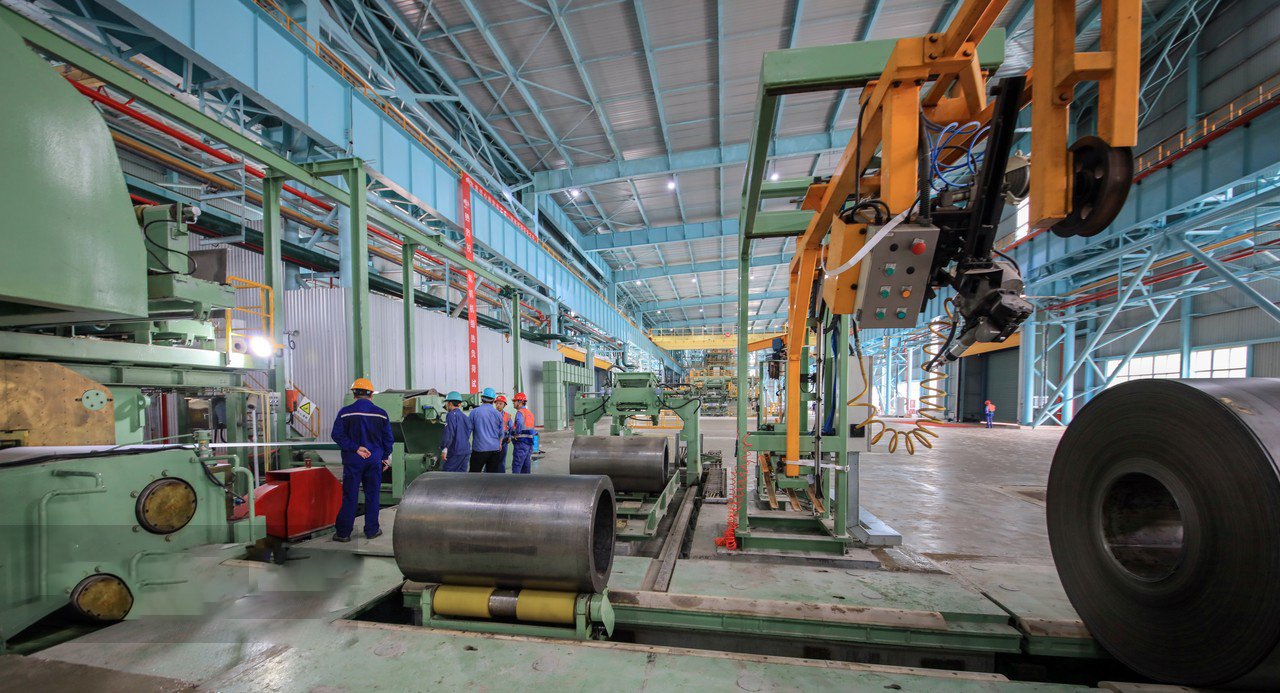
The value of 0.1mm 304 stainless steel coil is rooted in a triad of properties that make it uniquely suited for high-precision applications. These are not just marketing terms; they are quantifiable characteristics that dictate the material's performance and reliability. As the Global Business Director at MFY, I've had countless conversations with engineers who have pushed the boundaries of what's possible, and their success often comes back to a deep appreciation for the material's core features. They rely on our ability to deliver on these features without fail, a promise we can make because we control the entire production process. Understanding these features in detail is the first step toward successful innovation and manufacturing excellence.
Unpacking Corrosion Resistance and Chemical Stability
The primary reason Grade 304 is the workhorse of the stainless steel world is its exceptional resistance to a wide range of corrosive agents. This resilience stems from its chemical composition, specifically a minimum of 18% chromium and 8% nickel. The chromium reacts with oxygen in the air to form a thin, invisible, and incredibly durable passive chromium oxide layer on the surface. This layer is self-healing; if scratched or damaged, it instantly reforms, protecting the underlying steel from rust and corrosion. This is not just a surface-level benefit; it’s a fundamental characteristic that ensures longevity.
I recall working with a new client, a medical device manufacturer in Southeast Asia, who was developing a new line of minimally invasive surgical tools. Their primary concern was sterilization. The tools would be subjected to repeated autoclaving cycles, a high-heat, high-moisture process, as well as aggressive chemical disinfectants. Any sign of corrosion would be catastrophic, posing a direct risk to patient safety. They chose our 0.1mm 304 coils to form delicate but critical components of their instruments. The material's proven stability and resistance to pitting corrosion under these harsh conditions gave them the confidence they needed to move into full-scale production, a testament to the reliability that chemical stability provides.
It's also important to have a nuanced understanding of its limitations. While 304 stainless steel performs admirably in most atmospheric and chemical environments, it can be susceptible to pitting and crevice corrosion in environments with high chloride concentrations, such as coastal marine areas or applications involving direct contact with certain salts. In such specific cases, we advise clients to consider Grade 316 steel3, which includes molybdenum for enhanced chloride resistance. This transparent, consultative approach ensures our clients get the right material for their specific context, not just a one-size-fits-all solution.
The Critical Role of Formability and Ductility
At a thickness of just 0.1mm, the material must be able to be shaped into complex geometries without fracturing or losing its integrity. This is where the concepts of formability and ductility become paramount. In its most common annealed state, 304 stainless steel exhibits a low yield strength and high elongation percentage. In practical terms, this means it can be bent, stamped, drawn, and formed into intricate shapes with relative ease. This ductility is what allows for the creation of components like delicate electronic shields, flexible connectors, and complex diaphragms.
A perfect example comes from a project with an electronics integrator in the Middle East. They were designing a new EMI (electromagnetic interference) shield for a compact telecommunications device. The design required sharp bends and a precise, custom-fit shape to maximize shielding effectiveness without adding bulk. The 0.1mm thickness was essential for lightweighting, but the ductility of our 304 coil was the real hero. It allowed their automated stamping machines to operate at high speeds without causing stress cracking at the bend radii. We collaborated with their engineering team, providing test coils with a specific temper (a measure of hardness) to fine-tune their process, which ultimately helped them reduce their production scrap rate by over 15%.
The concept of "temper" is crucial here and demonstrates the versatility of the material. While the soft, annealed state is ideal for extensive forming, 304 steel can also be cold-worked to achieve various tempers, from quarter-hard to full-hard. As the material is worked, its tensile strength increases while its ductility decreases. A client producing small, spring-like components for an automotive sensor, for instance, would require a harder temper to ensure the part retains its shape and provides the necessary tension. By offering a range of tempers, we can tailor the material's mechanical properties to the precise functional requirements of the final application.
Precision in Thickness and Surface Finish
For a material measured in fractions of a millimeter, consistency is everything. In high-precision applications, the thickness tolerance is not a suggestion—it's a critical specification. For a 0.1mm coil, even a deviation of a few micrometers can render a batch of components useless, whether it's a sensor diaphragm that won't calibrate correctly or a shim that fails to provide the exact required spacing. This is where MFY's investment in a fully integrated supply chain pays dividends for our clients. By controlling the entire process, from the raw material melt to the sophisticated sensimirror cold-rolling mills, we can maintain exceptionally tight thickness tolerances across the entire length and width of the coil.
Equally important is the surface finish. The finish affects not only the aesthetic appearance of the part but also its performance and suitability for subsequent processing. The two most common finishes for thin-gauge coils are 2B and BA. A 2B finish is a smooth, moderately reflective cold-rolled finish that serves as a general-purpose standard for most applications. A BA, or Bright Annealed, finish is produced by heat-treating the steel in a controlled, oxygen-free atmosphere. This results in a highly reflective, mirror-like surface that is often specified for decorative applications or parts where maximum cleanliness and smoothness are required.
I worked with a construction contractor specializing in high-end architectural elements. They required 0.1mm 304 strips for a decorative interior application where a flawless, reflective surface was non-negotiable. We supplied them with a BA finish coil, which met their aesthetic requirements perfectly. The defect-free surface also meant they had minimal polishing work to do post-installation, saving them significant labor costs. A smooth, clean surface is also critical in technical applications. For electronics manufacturers, a pristine surface ensures proper adhesion of coatings and photoresists, while in medical applications, it minimizes areas where bacteria can harbor.
| Feature | Finish Type | Description | Common Applications |
|---|---|---|---|
| Smoothness | 2B | Smooth, moderately reflective, general-purpose | Gaskets, shims, non-visible parts |
| Reflectivity | BA (Bright Annealed) | Highly reflective, mirror-like | Decorative trim, reflectors, medical devices |
| Process | Cold Rolled, Annealed, Pickled | Cold Rolled, Annealed in controlled atmosphere | Demands higher process control |
Industry studies have consistently shown that microscopic surface defects can become initiation points for fatigue cracks, especially in thin-gauge materials subjected to vibration or cyclic loading. By ensuring a uniform, clean, and defect-free surface, we are not just providing a cosmetically pleasing product; we are fundamentally enhancing the reliability and lifespan of the final component our clients produce. This attention to detail at the microscopic level is what separates a standard commodity supplier from a true engineering partner.
304 steel resists corrosionTrue
The 18% chromium content forms a protective oxide layer that prevents rust.
304 steel is brittleFalse
304 steel has high ductility and can be formed into complex shapes without fracturing.
How does the thickness of 0.1mm affect the performance of stainless steel 304 coils?
Are you unsure how an ultra-thin material will hold up in your application? Choosing a gauge without understanding its performance implications can lead to over-engineering or, worse, unexpected failure. See how the 0.1mm thickness fundamentally changes the material's behavior, offering unique advantages.
The 0.1mm thickness of stainless steel 304 coils dramatically enhances flexibility and formability, allowing for intricate designs and lightweighting. However, it also reduces structural rigidity and load-bearing capacity compared to thicker gauges, making it ideal for non-structural components where precision and low mass are priorities.
The decision to use a material as thin as 0.1mm is a deliberate engineering choice, driven by a specific set of performance goals. I've guided many clients through this decision process, helping them weigh the trade-offs. For example, an engineering contractor working on a custom HVAC system needed to create complex heat exchanger fins. Thicker material was too rigid to form into the high-density fin pattern their efficiency models required. By switching to our 0.1mm 304 coil, they achieved the required shape, which maximized the surface area for heat transfer. The material's reduced structural strength was irrelevant in this application, as the fins were supported within a larger assembly. This illustrates a key principle: the "performance" of a material is relative to its intended function. The thin gauge was not a compromise; it was an enabler of a more efficient design. Understanding this balance is crucial for leveraging the full potential of ultra-thin stainless steel.

Exploring the impact of this minimal thickness reveals a fascinating interplay of mechanical and physical properties. It's a world where the rules of conventional material selection are redefined. The performance isn't simply "better" or "worse" than thicker steel; it's fundamentally different. This shift opens up new avenues for product design, particularly in industries driven by miniaturization and efficiency. At MFY, our deep involvement in the entire stainless steel supply chain gives us a unique perspective on how these subtle changes in gauge affect everything from raw material selection to final application performance. We don't just produce thin coils; we partner with clients to help them master the unique engineering challenges and opportunities that this specialized material presents.
Enhanced Flexibility and Formability
The most immediate and obvious effect of the 0.1mm thickness is a dramatic increase in flexibility. The material can be bent, folded, and wrapped with a minimal radius without fracturing, behaving more like a robust foil-like stainless steel4 than a rigid sheet. This characteristic is a direct result of the physics of bending: the stress induced in a material during bending is proportional to its thickness. By reducing the thickness, we drastically lower the stress for a given bend radius, allowing for much tighter and more complex forming operations. This is a game-changer for applications requiring non-linear shapes or components that need to be flexible in service.
Consider the case of a client in the renewable energy sector who was developing next-generation flexible solar panels. They needed a backing material that was durable, corrosion-resistant, and flexible enough to be rolled and unrolled repeatedly. Our 0.1mm 304 coil was the ideal candidate. Its inherent ductility, combined with the extreme thinness, provided the required flexibility. Thicker gauges would have created too much stress during rolling, leading to fatigue and failure over time. Their innovation was only possible because a material with this specific performance profile existed.
This enhanced formability also has a significant impact on manufacturing processes. It enables the use of high-speed, progressive die stamping to create incredibly intricate parts in a single operation. I worked with a manufacturer of electronic components who produced EMI shielding cages. Using our 0.1mm coil, they were able to consolidate three separate manufacturing steps into one continuous stamping process. The material was ductile enough to be drawn, pierced, and formed into its final complex shape without tearing, which increased their throughput by 40% and significantly lowered the cost per part.
The Trade-off: Structural Strength and Load-Bearing Capacity
While the thinness provides flexibility, it comes with an unavoidable trade-off in structural strength and rigidity. A 0.1mm sheet of steel simply cannot support the same load as a 1mm or 2mm sheet. Its buckling resistance, tensile strength (in terms of total force, not stress), and overall rigidity are significantly lower. This is a critical consideration that designers must account for. The material is not suitable for primary structural roles where it would be expected to bear significant weight or resist high impact forces on its own. Misunderstanding this limitation is a common source of design failure.
However, this perceived weakness is often irrelevant or even advantageous in the right context. I remember consulting for a construction contractor who was designing a lightweight facade system for a high-rise building. They used 0.1mm 304 panels as a decorative and protective rainscreen. The panels themselves had minimal structural load; the weight was carried by an underlying aluminum support frame. Here, the low rigidity was a benefit, as it made the large panels easier to handle and install, and the overall lightness reduced the dead load on the building's main structure. The project was a success because the designers correctly identified the material's role as a high-performance "skin" rather than a structural "bone."
This trade-off is quantified by metrics like the moment of inertia, a measure of a cross-section's resistance to bending, which is highly dependent on thickness. A comparison of a 0.1mm strip versus a 1.0mm strip of the same width shows that the thicker strip is orders of magnitude more rigid. Acknowledging this, engineers often incorporate design features like ribs, bends, or corrugations into parts made from thin-gauge material. These geometric features dramatically increase the component's stiffness without increasing its weight, allowing them to achieve the necessary performance while still benefiting from the material's thinness.
Impact on Thermal and Electrical Performance
The thickness of a material also influences its thermal and electrical properties, a factor that is especially critical in electronics and heat transfer applications. For heat transfer, a thinner material presents less of a barrier, allowing for faster and more efficient thermal conduction through the material itself. This is why our 0.1mm coils are frequently chosen for applications like heat exchanger fins or the casings for electronic components where efficient heat dissipation is crucial for performance and longevity. A study in the Journal of Heat Transfer5 demonstrated that reducing material thickness in fin-and-tube heat exchangers directly correlates with a higher heat transfer coefficient, improving overall system efficiency.
For electrical applications, the situation is more nuanced. While stainless steel is a conductor, it has significantly higher electrical resistance than materials like copper or aluminum. In a 0.1mm cross-section, this resistance can be substantial. This property is leveraged in applications like precision resistors, where a specific resistance value is required. However, it's most commonly used for EMI/RFI shielding. In this role, the conductive surface reflects and absorbs electromagnetic waves, protecting sensitive electronics inside an enclosure. The 0.1mm thickness is typically sufficient to provide effective shielding across a wide range of frequencies, offering a lightweight and corrosion-resistant solution.
I recently worked with an equipment integrator building custom control cabinets for a manufacturing plant. They were experiencing interference issues between high-power drives and sensitive control logic. We provided them with 0.1mm 304 coils, which they used to line the interior of the cabinets and create partitioned shields. The material's formability allowed them to easily fit it into tight spaces, and its surface conductivity was sufficient to ground the interference and solve the problem. They achieved the required electrical performance without the weight and cost of using thicker aluminum or specialized shielding materials, showcasing how the material's properties at this specific gauge can provide an optimal, multi-faceted solution.
0.1mm steel enhances flexibilityTrue
The reduced thickness significantly lowers bending stress, enabling tighter forming operations without fracturing.
Thinner steel has higher load capacityFalse
0.1mm steel has reduced structural rigidity and buckling resistance compared to thicker gauges.
What are the common applications of 0.1mm stainless steel 304 coils?
Are you wondering if this ultra-thin material is the right fit for your industry? Applying a material outside of its proven use cases can be risky and inefficient. Explore the diverse range of applications where 0.1mm 304 stainless steel coil consistently delivers exceptional results.
Common applications include precision electronics like EMI shielding and flexible connectors, medical devices such as surgical instruments and implants, automotive components like gaskets and shims, and architectural elements. Its unique properties make it ideal for industries prioritizing miniaturization, hygiene, and precision.
The versatility of this material is something I see every day. Its applications span nearly every advanced industry. For instance, a long-term client of ours, a major distributor in Russia, supplies our 0.1mm coils to a wide array of local manufacturers. One month, the demand will be driven by a producer of medical diagnostic equipment needing material for sensor diaphragms. The next, an automotive parts manufacturer will place a large order for producing heat shields. This diversity is a testament to the material's fundamental utility. It's not a niche product for a single purpose; it's a foundational material for modern engineering. My role at MFY allows me to see this firsthand, connecting our production capabilities in China with the innovative applications happening worldwide, from a high-tech lab in the Middle East to a bustling factory in Southeast Asia.
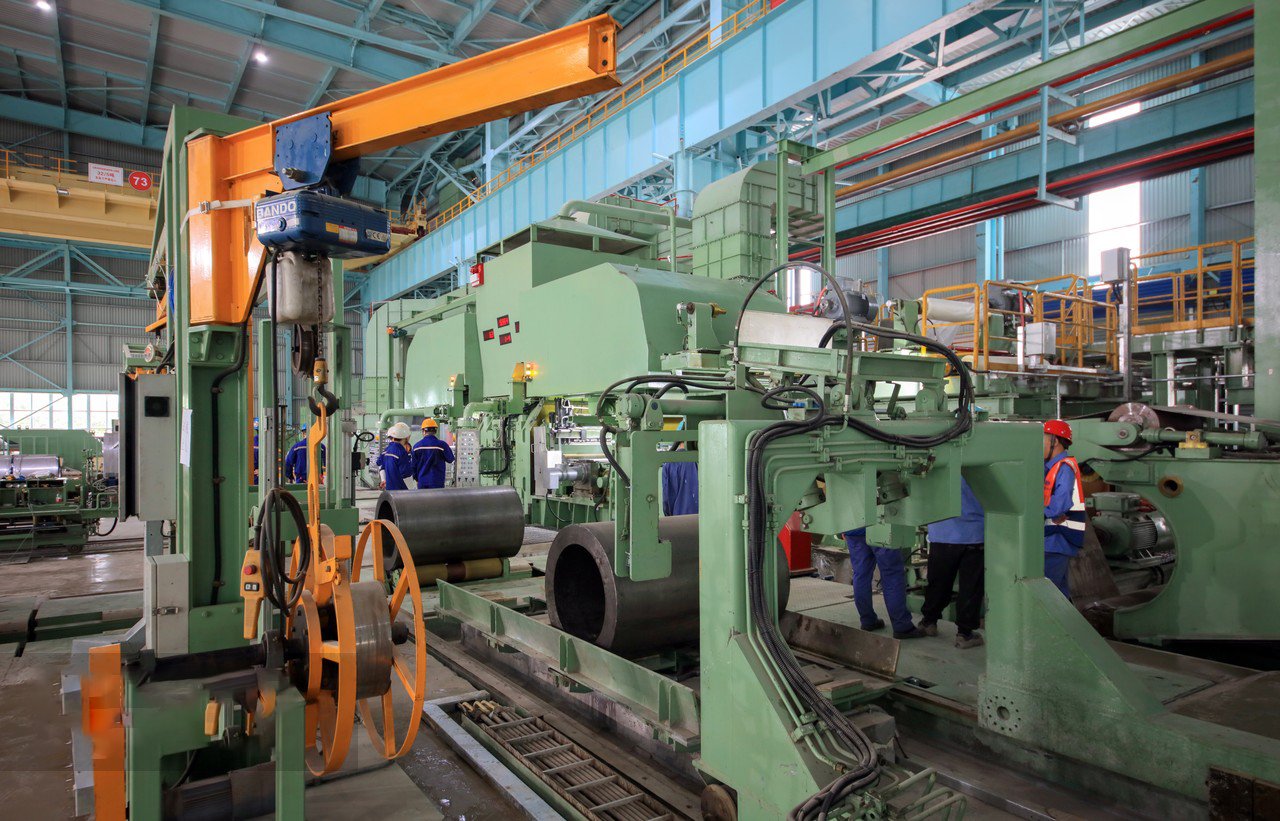
The widespread adoption of 0.1mm stainless steel 304 coil across different sectors is not a coincidence. It is a direct result of the material’s ability to solve critical challenges related to weight, space, durability, and formability. As manufacturing trends lean further into miniaturization and efficiency, the demand for such high-performance, thin-gauge materials continues to grow. Each application leverages a specific combination of the coil's key features, whether it's the corrosion resistance for a medical tool, the formability for an electronic shield, or the heat resistance for an automotive part. At MFY, our global reach allows us to witness these trends as they emerge, providing us with invaluable insights that we pass on to our clients, helping them stay ahead of the curve.
Precision Electronics and Telecommunications
In the world of electronics, every millimeter and every gram counts. The relentless drive to make devices smaller, lighter, and more powerful makes 0.1mm 304 stainless steel an indispensable material. One of its most prevalent uses is for EMI (Electromagnetic Interference) and RFI (Radio Frequency Interference) shielding6. Sensitive microchips and components are encased in "cages" or shields formed from this material. Its conductive surface effectively blocks stray electromagnetic fields, preventing interference that could disrupt performance. The material's excellent formability allows these shields to be stamped into complex, custom-fit shapes that conform perfectly to crowded circuit boards.
I have personally worked with numerous manufacturing companies in the telecommunications sector who rely on our coils for this very purpose. A key client in Southeast Asia, a producer of 5G networking equipment, uses our 0.1mm material to shield critical signal processing units. The thinness is vital for heat dissipation and maintaining the device's compact form factor, while its strength provides robust protection for the delicate electronics within. Their continued reliance on our material stems from our ability to provide coils with a consistent surface finish and tight tolerances, which is critical for their high-speed, automated assembly lines.
Beyond shielding, it's also used for a variety of other components. This includes ultra-thin springs, flexible connectors that need to withstand repeated bending, battery casings, and precision brackets. In each of these cases, the combination of 304's corrosion resistance, non-magnetic properties (in the annealed state), and mechanical resilience at a minimal thickness makes it a superior choice to plastics or other metals.
Medical Devices and Scientific Instruments
The medical industry operates under the strictest standards of hygiene, reliability, and biocompatibility. Stainless steel 304 is widely accepted for medical use due to its excellent corrosion resistance7, which allows it to withstand aggressive sterilization procedures like autoclaving. At the 0.1mm thickness, it is used to manufacture a host of critical components. This includes fine surgical blades, needles, clamps, and parts for minimally invasive surgical instruments where both strength and some degree of flexibility are required.
A compelling case I was involved with was a startup developing a novel drug-delivery device. They needed to manufacture a microscopic diaphragm that would flex under pressure to release a precise dose of medication. The component needed to be biocompatible, impervious to the chemical composition of the drug, and have a highly predictable flex cycle. Our 0.1mm 304 coil, supplied with a certified chemical composition and a bright annealed (BA) finish for maximum cleanliness, met their exacting requirements. Our ability at MFY to provide full material traceability from melt to final product was a crucial factor in their selection process, as it is a non-negotiable requirement for medical device approval.
Furthermore, this material is common in scientific and laboratory equipment. Applications range from microscope slide clips and precision shims for calibrating instruments to fine mesh filters and casings for sensors. In these environments, chemical inertness and the ability to be easily cleaned are paramount. The durability of stainless steel ensures a long service life, even with heavy use, making it a cost-effective and reliable choice for labs and research facilities.
Automotive and Aerospace Components
The automotive and aerospace industries are constantly battling to reduce weight to improve fuel efficiency and performance. While 0.1mm stainless steel isn't used for primary structural frames, it is a champion in a multitude of non-structural and component-level applications. One of the most common uses is in the manufacturing of multi-layer steel (MLS) head gaskets8 for internal combustion engines. Thin layers of stainless steel, often with specialized coatings, are stacked to create a gasket that can withstand extreme temperatures and pressures while providing a perfect seal. The 0.1mm thickness allows for the precise layering needed to achieve the required sealing properties.
I recall an engagement with an engineering contractor that specialized in aftermarket automotive performance parts. They were designing a high-performance exhaust system and needed a material for heat shields that could protect surrounding components from radiant heat. The material had to be lightweight, resistant to high temperatures and corrosive exhaust gases, and easily formed to fit in the tight confines of an engine bay. Our 0.1mm 304 coil was the perfect fit. It provided the necessary thermal barrier and corrosion resistance, and its formability allowed them to create complex, effective shield geometries.
In aerospace, the applications are similar, but with an even greater emphasis on weight savings and reliability. It's used for shims to ensure precise alignment of components, for lightweight brackets, for firewall insulation retainers, and for ducting components in environmental control systems. In these applications, every component is scrutinized for its weight-to-performance ratio, and 0.1mm stainless steel often provides the optimal balance of durability, heat resistance, and low mass.
304 stainless steel is used in EMI shieldingTrue
The conductive properties of 0.1mm 304 stainless steel make it effective for blocking electromagnetic interference in electronics.
0.1mm steel is used for car framesFalse
While used in automotive components, 0.1mm stainless steel is too thin for structural car frames which require much thicker materials.
What factors should be considered when selecting 0.1mm stainless steel 304 coils?
Are you ready to source this material but worried about making the wrong choice? Selecting a supplier based on price alone can lead to inconsistent quality, production delays, and material that fails to perform. Understand the critical factors beyond the spec sheet to ensure you partner for success.
Beyond confirming the grade (304 stainless steel) and thickness (0.1mm), you must consider dimensional tolerances (width/thickness), temper (hardness), surface finish (e.g., 2B, BA), and coil specifications (ID/OD, weight). Crucially, evaluating the supplier's quality control systems and supply chain reliability is paramount.
Making the right choice is about more than just matching numbers on a data sheet. It's about ensuring the material you receive is fit for your purpose, coil after coil. I once had a new client, a large distributor, who came to us after a major issue with a previous supplier. They had ordered a large batch of 0.1mm coil that was technically "in spec" but had significant crown (thickness variation across the width). This caused major problems in their customer's slitting operation, leading to waste and delays. This is why at MFY, our integrated production model is so important. It allows us to control factors like crown and edge quality, details that make a huge difference in our clients' processes but are often overlooked in a simple quote. Choosing a supplier is choosing a partner in quality.

Selecting the right 0.1mm stainless steel 304 coil is a multi-faceted decision that directly impacts manufacturing efficiency, final product quality, and your bottom line. A superficial evaluation can easily miss the nuances that separate a high-quality, reliable material from a low-cost alternative that creates downstream problems. As a company that has built its reputation on an integrated and transparent supply chain, we at MFY encourage our clients to look deeper. The right questions go beyond price and lead to a partnership that provides not just steel, but confidence and reliability. From mechanical properties to logistical considerations, a thorough evaluation ensures that the coil you procure is precisely what your application demands.
Mechanical Properties and Material Condition
The first level of specification goes beyond simply "304 grade." You must define the required mechanical condition of the material, which is primarily determined by its "temper." A coil supplied in the soft, annealed condition will have excellent ductility and be perfect for applications involving deep drawing or extensive forming. However, if your component needs to function as a spring or a clip, you will need a harder temper (e.g., 1/4 hard, 1/2 hard, full hard) achieved through cold rolling. Specifying the wrong temper will result in product failure; an annealed part won't have the necessary spring-back, while a full-hard part may fracture during forming.
A classic example is a manufacturer of precision snap domes for electronic keypads. They require a material with a very specific tensile strength and hardness to achieve the desired tactile "click" and a long cycle life. We worked closely with their engineering team, providing several samples with slightly different tempers. Through testing, they identified the exact mechanical property range that optimized performance. We were then able to lock in that specification for all future orders, ensuring 100% consistency for their production line. This level of collaboration is essential.
Furthermore, it's vital to ensure the material meets international standards like ASTM A2409 for chemical composition and mechanical properties. A reputable supplier should be able to provide a Material Test Certificate (MTC) or 3.1 Certificate for every coil, detailing the exact chemical analysis and results from mechanical tests (tensile strength, yield strength, elongation). This documentation is your guarantee of quality and traceability.
Dimensional Tolerances and Coil Specifications
For ultra-thin materials, precision is everything. You must clearly define the required dimensional tolerances for thickness and width. Standard commercial tolerances may not be sufficient for high-precision applications. If your process, for example, involves slitting the master coil into very narrow strips, a tight width tolerance is essential to minimize scrap. Similarly, as discussed before, thickness variations across the coil can disrupt automated processes and lead to inconsistent part quality. Discuss your specific tolerance requirements with your supplier to ensure their production capabilities can meet them. At MFY, our advanced cold-rolling mills enable us to offer tolerances that are often tighter than industry standards.
Beyond the material itself, you need to consider the physical specifications of the coil. This includes the inner diameter (ID), the maximum outer diameter (OD), and the maximum coil weight. These factors must be compatible with your uncoiling and processing equipment. Ordering a coil with a 508mm ID when your decoiler is designed for a 406mm ID will lead to significant downtime and handling issues. Similarly, a coil that is too heavy for your crane or too large for your storage space can create major logistical headaches.
I always have a pre-order checklist discussion with new clients. We walk through their entire process, from receiving and storage to the final stamping or forming machine. A client in India, a large-scale manufacturing company, was able to increase their production efficiency simply by optimizing coil specifications. By switching to larger, heavier coils, they reduced the number of coil changes required per shift, resulting in a measurable increase in machine uptime and overall output. This practical, logistical alignment is a crucial but often overlooked factor in supplier selection.
Supplier Reliability and Supply Chain Integrity
Perhaps the most critical factor, especially for businesses that rely on just-in-time inventory, is the reliability of the supplier and their supply chain. A low price is meaningless if the material arrives late, is of inconsistent quality, or is poorly packaged and damaged in transit. You should evaluate a potential supplier's track record, production capacity, and logistical expertise. How do they ensure quality control throughout the manufacturing process? How do they package such a delicate material to prevent damage during a long sea voyage? What is their typical lead time for production and export delivery?
This is where MFY's core strengths become a key advantage for our clients. Our fully integrated supply chain means we are not just a trader; we control the process from the start. This gives us unparalleled oversight of quality and production scheduling. Our strong production capacity and inventory levels mean we can offer rapid export delivery, a critical factor for clients in fast-moving markets like Southeast Asia and the Middle East. We understand the importance of robust packaging, using interleaving paper and secure crating to ensure our coils arrive in pristine condition.
I encourage potential clients to think of us not just as a supplier in China, but as their international supply chain partner. Ask about our experience in your specific market. For instance, our extensive experience shipping to India means we have a deep understanding of the customs procedures and logistical networks, ensuring a smoother, more predictable delivery process. A reliable supplier doesn't just sell you a product; they provide a service that de-risks your international procurement and helps you build a more resilient and competitive supply chain.
Temper affects material hardnessTrue
The temper (e.g., annealed, 1/2 hard) directly determines the mechanical properties and hardness of stainless steel coils, which must match the application requirements.
Coil ID doesn't matterFalse
The inner diameter (ID) of coils must match your decoiler equipment specifications, otherwise it will cause handling issues and downtime.
What are the best practices for handling and storing 0.1mm stainless steel 304 coils?
Are you concerned about damaging your investment before it even reaches the production line? Improper handling of ultra-thin coils can easily lead to creases, scratches, and corrosion, rendering expensive material useless. Learn the essential practices to protect your material and ensure its integrity.
Best practices include storing coils flat in a dry, climate-controlled environment, leaving them in their original protective packaging until use, using proper lifting equipment (e.g., C-hooks, saddles) to avoid pressure points, and handling with clean gloves to prevent surface contamination.
The fragility of this material cannot be overstated. I visited a client's facility and saw firsthand the consequences of poor handling. A new warehouse operator had tried to lift a coil with a standard forklift, denting the edges and creasing the outer wraps. That entire section of the coil was scrap. It was a costly lesson in the importance of specialized procedures. Following best practices isn't about being overly cautious; it's about protecting the precision and quality you paid for, ensuring that the material fed into your machines is as perfect as the day it was produced.
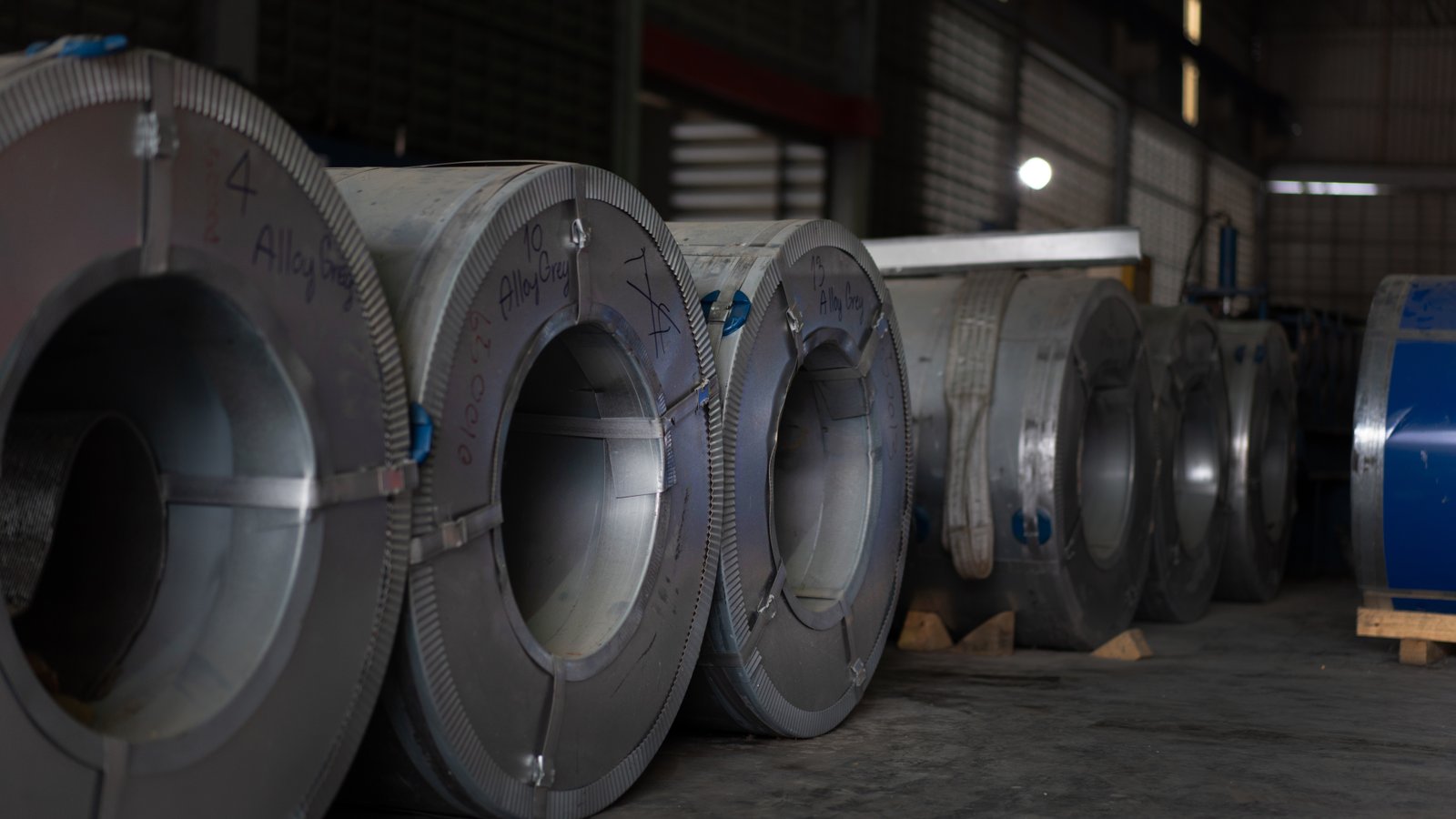
The journey of a 0.1mm stainless steel coil10 from our factory to your production floor is the final, critical step in ensuring quality. All the advanced manufacturing and meticulous quality control we implement at MFY can be undone in moments by improper handling or storage. This material is not like standard-gauge steel; it is a high-precision product that demands respect and care. Adopting best practices is fundamental to preventing waste, ensuring manufacturing efficiency, and safeguarding the quality of your final products. As your partner, we believe our responsibility extends to providing the guidance necessary to maintain the material's pristine condition until the moment of use.
Proper Storage Environment and Packaging
The first line of defense is creating a safe storage environment. The ideal location is a clean, dry, and climate-controlled indoor area. Humidity is the enemy. While 304 stainless steel11 is corrosion-resistant, prolonged exposure to moisture, especially if the coil is tightly wound, can lead to crevice corrosion or water staining between the wraps. Storing coils away from open doors, windows, and any sources of condensation is crucial. The temperature should be kept as stable as possible to prevent the "sweating" that occurs when cold material is brought into a warmer, humid environment.
It is essential to keep the coils in their original protective packaging for as long as possible. As a supplier, we take great care in packaging. At MFY, our export-grade packaging involves wrapping the coil in anti-rust paper and a plastic film, then placing it on a pallet or skid, often within a custom-built wooden crate for maximum protection. This packaging is designed to shield the coil from moisture, dust, and physical damage during transit and storage. Opening it prematurely exposes the delicate surface to environmental hazards and increases the risk of accidental damage.
I always advise clients to implement a "first-in, first-out" (FIFO) inventory system. This ensures that the oldest stock is used first, minimizing the total time any single coil spends in storage. Even under ideal conditions, it's simply good practice to keep inventory rotating. For long-term storage, periodic inspection of the packaging for any breaches is a wise precaution.
Safe Handling and Lifting Techniques
Due to its thinness, 0.1mm coil is extremely susceptible to physical damage. Creases, kinks, dents, and edge damage are often irreversible and will cause significant problems in processing. Standard lifting equipment like chains or standard forklift tines must never come into direct contact with the coil. Direct pressure will crush the edges and deform the wraps. The proper way to lift a coil is with equipment designed to distribute the load evenly. This includes using wide, fabric belt slings, C-hooks that support the coil from its inner diameter, or vertical eye-coil lifters.
When moving the coil, all movements should be smooth and controlled. Sudden starts or stops can cause the wraps to shift and abrade against each other. When placing the coil down, it should be set on a clean, flat pallet or a designated saddle cradle that supports its curved shape. Never store a coil by laying it on its side (like a coin on a table) without proper support, as the weight can cause the edges to flare or collapse.
Personal handling procedures are just as important. Anyone handling the raw coil should wear clean, lint-free gloves. Fingerprints and hand oils can etch the surface of the steel over time, leading to cosmetic defects or even localized corrosion. This is especially critical for coils with a Bright Annealed (BA) finish, where every mark will be visible. Training for all warehouse and production staff on these specific handling procedures is not just a recommendation; it should be a mandatory part of your operational protocol.
Uncoiling and Processing Preparation
The transition from storage to the production line is another critical point where damage can occur. The uncoiling (or decoiling) process must be done carefully. The leading edge of the coil can be sharp and should be handled with caution. When feeding the material into a machine, it is vital to ensure that all guides, rollers, and surfaces that the steel will touch are clean, smooth, and free of burrs or debris that could scratch the surface.
Tension control on the decoiler and the processing line is paramount. Too much back-tension can stretch or deform the ultra-thin material, altering its mechanical properties and dimensions. Too little tension can allow the coil to loosen, risking tangles and damage. The tension settings should be carefully calibrated specifically for the 0.1mm gauge. It is also important to manage the scrap from the outer and inner wraps. The first few and last few wraps of a coil may have been exposed to more handling stress and are often discarded to ensure only pristine material enters the production process.
I worked with a client who was experiencing intermittent scratching on their stamped parts. After a process audit, we discovered the issue wasn't the steel quality but small metal filings that had become embedded in the felt pads of their feeder guides. By implementing a simple, regular cleaning schedule for their processing line, the problem was eliminated entirely. This highlights that maintaining material integrity is a holistic process, extending from the storage warehouse all the way to the stamping die.
Store coils flat in dry environmentTrue
0.1mm stainless steel coils should be stored flat in a dry, climate-controlled space to prevent moisture damage and maintain material integrity.
Use standard forklifts for lifting coilsFalse
Standard forklifts can damage thin coils; specialized equipment like C-hooks or fabric slings should be used to distribute weight evenly.
Conclusion
Ultimately, the 0.1mm stainless steel 304 coil is a high-performance material defined by precision. Its success in your application hinges on understanding its features, performance trade-offs, and handling requirements, and, most importantly, on partnering with a supplier who guarantees quality from production to delivery.
-
Discover the properties and compliance details of 1.4404 stainless steel under EN 10088 ↩
-
Learn about critical differences in mechanical properties essential for compliance and application safety ↩
-
Learn about EN 10088's importance in European structural engineering projects ↩
-
Learn how specifications guide the choice of material standards for your project ↩
-
Discover how project documentation ensures material compliance and quality ↩
-
Understand the role of 304 stainless steel in electronic interference protection ↩
-
Discover the corrosion resistance of 304 stainless steel in medical use ↩
-
Explore 0.1mm stainless steel's application in automotive gaskets ↩
-
Understand the key requirements of ASTM A240 for stainless steel products. ↩
-
Learn how to properly store and handle ultra-thin stainless steel coils ↩
-
Explore the impact of humidity on 304 stainless steel and storage solutions ↩
Have Questions or Need More Information?
Get in touch with us for personalized assistance and expert advice.
